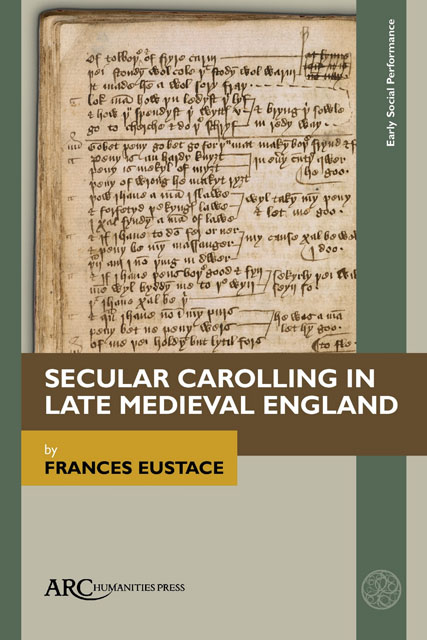Book contents
- Frontmatter
- Contents
- List of Illustrations
- Preface
- Introduction
- Chapter 1 Carolling and Dance-Song in the Context of a Primarily Oral Culture
- Chapter 2 Courtly Carolling: Contexts and Practices
- Chapter 3 The Church, Carolling, and the Emergence of the English Franciscan Carole Writers of The Fourteenth and Fifteenth Centuries
- Chapter 4 Carole Texts in Context: The Manuscripts
- Chapter 5 Carole Texts as Witnesses to Carolling Practice
- Chapter 6 Survivances Of Carolling In Folk Culture
- Conclusion: Carolling from a Dance Movement Psychotherapy Perspective
- Bibliography
- Index
Chapter 6 - Survivances Of Carolling In Folk Culture
Published online by Cambridge University Press: 06 April 2023
- Frontmatter
- Contents
- List of Illustrations
- Preface
- Introduction
- Chapter 1 Carolling and Dance-Song in the Context of a Primarily Oral Culture
- Chapter 2 Courtly Carolling: Contexts and Practices
- Chapter 3 The Church, Carolling, and the Emergence of the English Franciscan Carole Writers of The Fourteenth and Fifteenth Centuries
- Chapter 4 Carole Texts in Context: The Manuscripts
- Chapter 5 Carole Texts as Witnesses to Carolling Practice
- Chapter 6 Survivances Of Carolling In Folk Culture
- Conclusion: Carolling from a Dance Movement Psychotherapy Perspective
- Bibliography
- Index
Summary
WE HAVE SEEN in the foregoing chapters that medieval carolling was the activity of singing and dancing at the same time but that the two components appear to have taken separate lines of development in England after ca. 1500, according to the written record. It is possible that the combination of singing and dancing in dance-songs remained in oral culture far later, but the terms “carol” and “carolling” became attached to the seasonal song element alone. People continued to accompany their activities with songs, especially in the contexts of communal agricultural work, rowing, sailing and presumably dancing, in the absence of available musical instruments. However, the written record is fragmentary for the period from the sixteenth century until the interest in what came to be called “folk” culture blossomed in the nineteenth century. Recently, Robert Mullally has argued that the carole, as a medieval French dance, “went out of fashion about 1400.” Moreover, he continues, “The fact remains, however, that no obvious relationship is discernible between the carole as a dance and the carol as a burden-and-stanza form,” and that this English “lyric form,” though the name “carol” was applied to it, was unrelated to dancing. We have also seen, however, that there existed a more fluid and complex relationship between the French or Anglo-Norman use of the word carole, and the central position of the activity in insular British culture than his view allows. The emergence of the polyphonic carol, for example, as exemplified by The Agincourt Carol in 1415, represents just one, well documented, direction that the song element of carolling took during the fifteenth century. This is described by Lefferts as follows:
The polyphonic English devotional carol in English and Latin is an important indigenous product […] that did not circulate abroad. Not the music of the noble courts but not the music of the people either, the carol appears to have been a repertory primarily for recreational use at Christmas and Eastertime in the world of the scholars, fellows and singing men of schools, colleges and major ecclesiastical choral establishments.
Certainly, singing and dancing followed separate paths of development in Britain, first in courtly culture and later in what might be referred to anachronistically as “folk” culture.
- Type
- Chapter
- Information
- Secular Carolling in Late Medieval England , pp. 97 - 130Publisher: Amsterdam University PressPrint publication year: 2022



